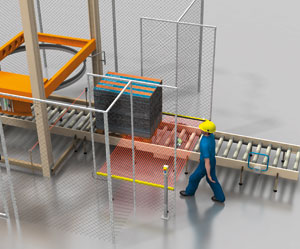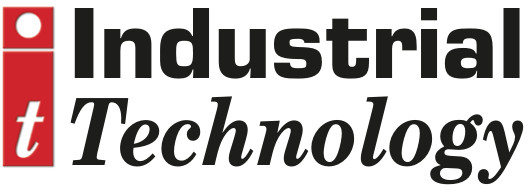
Posted to News on 22nd Jan 2016, 00:00
Seeing the light for more versatile safety
The Safety Light Curtain is relied on to protect the safety of factory personnel all over the world. Yet, though the technology was developed more than 65 years ago, many applications may still not be making full use of its capabilities. Is it time to re-appraise what light curtains could be contributing to your machinery safety, factory control and productivity, asks Dr Martin Kidman of Sick.

The light curtain has become so ubiquitous, that it is all too easy to regard it as a simple on/off device – a fail-safe, fit-and-forget substitute for protective fencing. An expanding and versatile range of light curtains has evolved to perform multiple functions. They can contribute positively to productivity and integrate with factory LANs to support better plant-wide automation.
In 1951, Erwin Sick presented the first wooden model of his light curtain to the German Inventor and New Development Trade Fair in Munich. Later the same year a patent registration of the light curtain based on the autocollimator principle was regarded as the technical breakthrough that began the development of technology we know today – one that has saved countless people from injury and death at the hands of dangerous machinery.
Since that time hardware and software development have transformed the versatility and use of light curtains. But while the key attributes of light curtains remain the same, their potential may still be under-exploited.
A back-to-basics re-view of any safety installation is usually revealing. So, what are the starting points for specifying a light curtain? There is really no such thing as a straight like-for-like off the shelf ‘menu’ of products. All manufacturers offer their own ranges of features, sizes, shapes and resolutions. The starting point is the danger you want to guard against and the dimensions of the area where unsafe access takes place. This gives the size of the protection zone in front of the hazard.
Then, there is the range of the light curtain, ie the maximum distance between emitter and detector. Products are available with either a fixed range, a selectable range, or recent developments such as the Sick deTec4 have introduced an auto-adjusting range. Choosing the correct range ensures that the light curtain is best fit for the application, for example, if a high power, long range, device is used over a short distance, reflections off nearby surfaces may make the installation unsafe. On the other hand, a long range device may be required for protecting large areas.
The resolution of a light curtain can also affect the mounting position with respect to the hazard. For short distances and point protection, usually ‘finger protection’ is used which has a resolution of 14mm. For larger distances and access protection a resolution of 400mm may be used, but then additional devices may be required for presence detection if the machine can be reset whilst a person is behind the light curtain. A thorough risk assessment according to EN ISO 12100 should be performed to take these points into consideration and EN ISO 13855 is the standard for positioning of the light guard with respect to the approach speeds of the human body.
Larger resolution light curtains are usually less expensive than lower resolutions, but switching to a large resolution means the distance between the field and the machine hazard must frequently be increased to be sufficient to fulfil safety requirements. This may impractical or not possible on the factory floor.
Figure 1 shows an example comparing different sizes, arrangements and types of light curtain with safety barriers. They are also compared to the protection afforded by a laser scanner alternative to light curtains that scans a detection field before the hazard. As can be seen, light curtains offer higher resolution and can also meet safety requirements up to PLe (using Type 4 light curtains; Type 2 curtains are no longer allowed for PLd/ SIL2.
The simplest function of the light curtain is to stop the machine if a light beam is broken. If no incident has occurred and the area is safe then a reset can be performed. But this stop/start style of safe operation can be disruptive to factory flow and productivity, whether on a single machine, a conveyor line for multi-operation processes, or in a logistics warehouse.
Today’s light curtain installations are much more attuned to production needs, capable of a wide range of manual and automatic actions that ensure a light curtain assists safety and productivity rather than sacrificing efficiency. This is facilitated by modern light curtains operating on 24V DC with dual channel ‘Output Signal Switching Devices (OSSDs). These can be connected directly to a safety plc, safety relay or even contactors (the latter, if external device monitoring is available for high performance levels). The unit’s connections are important in determining its additional capabilities.
If the light beam is broken as part of the normal cycle of operation – say to remove a finished workpiece after a press cycle and replace it – then what happens? Going through the whole reset/restart process can be time consuming.
One solution is to use ‘presence sensing device initiation’ mode, better known as PSDI. In PSDI mode, the light curtain still acts as the safeguarding device at certain times of a machine’s cycle, but it is also used to initiate a cycle when in a safe state. It should be noted that an automatic restart facility should only be used when there is no room for a person to stand between the safety device and the hazard (unless an external device such as a safety relay is performing the restart the interlock).
In some applications, it might be desirable to permit certain objects to protrude through the light curtain field, for example a support table or rack required to feed the machine with a heavy workpiece. In this case, a blanking facility allows the user to ‘turn off’ some of the beams and hence not interrupt the work flow. It can either be fixed or floating to allow a variable position for the object.
In many applications of light curtains, particularly on conveying lines with goods passing from one area of production to another, or in automated warehousing operations where staff are excluded from the automated stacking and shelving areas, a light curtain must be able to allow objects through whilst still reacting to people. Sensors can be used to identify the object such as a car body and allow passage, while not allowing an operative through due to the shape and size; this is automatic and known as muting.
Muting uses a combination of curtains and, frequently, single beam optical sensors in specific configurations to meet the application requirements. For more complex applications additional devices such as a safety laser scanner in a vertical orientation can be used to check exact profiles such as packages up to a certain size and shape.
A variation known as partial muting (or partial blanking) offers the capability of only muting selected light beams.
In some applications it is, at times, necessary to mute the protective field evaluation of the safety light curtain manually. This could be, for example, in a safe machine setup mode, in which the machine can be operated only in inch mode. This is called bypass and other protective measures should be forcibly activated in this mode. The bypass function may only be activated by a key-operated pushbutton with an automatic reset and two levels; or by two input signals that are independent of each other, for example two position switches.
In many applications, light curtains operate in close proximity to each other. In these installations, a beam from one transmitter curtain could accidentally impact the wrong receiver and create optical interference with the possibility of diminishing safety through interference and even disrupted production processes.
To eliminate problems some manufacturers offer beam coding, so that a beam detector can distinguish its own light signal from those of neighbouring devices. However, there is a slight penalty as beam coding can increase the response time which could affect the mounting distance and even the range of a safety light curtain which could affect the suitability. Cascading of light curtains could also be another solution to this problem in which senders and receivers are connected together to form irregular protective fields.
It is common for light curtains to be installed with all of the capabilities mentioned in this article, but without actually being used in the application. All of these features can make the light curtain easy to integrate with modern factory safety requirements for productive working whether as a stand-alone installation or in a complex entry/exit system combined with beams, scanners, sensors, gate switches and other equipment. Most of the features are integral to the light curtain, or may be controlled via an external controller or relay.
By using today’s capabilities to the full, the safety engineer and plant designer can now achieve a combination of features which enhance both safety and productivity.








